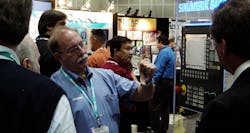As I’m retiring after 46 years in the machine tool and CNC world, I wanted to take this opportunity to say “thank you” to those who contributed to the most important memories I’ll carry into my next chapter in life. Namely, all of the great people I’ve known, mentors and co-workers, the employer who gave me a chance, and management folks at Siemens Inc. who supported my passion for training -- which culminated in the incredible Technical Application Center at the Machine Tool HQ of Siemens in Chicago.
My thanks go also to everyone I’ve trained in the classes I’ve presented over these years, in instructional programs, or demos staged at shows, or numerous onsite presentations at shops and factory production departments.
When I started in 1975, running a Bandit at DoAll in Chicago, the hot new thing was the NC tape drive. I worked on Bridgeport mills and other machines as I continued my career at Hundai, Iverson, Hardinge, Kitamura, Toyoda, and Romi, before finally arriving at Siemens, 21 years ago.
The transition from tape drives to a true CNC was underway, and machining experts and operators were still learning the enormous firepower and motion control capability of the CNC.
I had Norman Bleier as my mentor and for that I could not have been more fortunate: Norm was on the team that pioneered CNC. That man had an encyclopedic knowledge of the process, the hardware, and the software. Plus, he had that gift every great engineer is blessed with, an ability to think forward to the next level of technology… and to make it happen.
Along the way, it occurred to me that CNC training would be critical in the machine shop world, because many of the older operators worked in ways that simply were destined to go away, in favor of a new technology that was not being taught in schools, not even in trade schools at that the time. Worse, as educational funding was reduced, often the first thing to go was often the “shop class,” where I’d discovered my own love for making things.
Now, I can say that I am proud to have been involved in a great shop-class program at Lake Park High School in the Chicago area, where with financial support by Terry Iverson (of machine tool distributor Iverson & Co.) and others, I’ve helped with the machine tool selection and emulated controls.
If we don’t properly train the next generation of American manufacturers, we risk losing its manufacturing base and that simply cannot be allowed to happen.
Today, in Covid times, proper training is being done at the Siemens Virtual Technical Application Center, run by Chris Pollack. Thousands of current and potential machine operators, programmers, and maintenance personnel are being engaged with all the latest technologies. And they’re also picking up all the good old tips and tricks that great machinists always figure out, in order to keep their machines running at optimal productivity levels. Despite the tremendous capabilities onboard new machines with today’s CNCs – and even the robots tending those machines -- peak performances still rely on the people running those machines and controls.
For many years, training activities meant that I’d often spent 70-80% of my time traveling, and with apologies to my lovely bride I will miss some things about that. A funny moment happened when I mistakenly kept my cell phone in my pocket during a training visit to Oak Ridge National Lab. I soon found myself in a room with some men in black.
At Siemens Virtual Technical Application Center Chris and have had the advantage of doing everything virtually, which is very efficient, but I still miss that magic moment when a young person “gets it” and wants to take flight, soar, and create something very cool on his or her machine tool. I remember having such moments when I started machining, and smart old craftsmen would show me how to do something the right way. When I’m reflecting on my experiences, up in the mountains, swimming, taking photos, riding an ATV, or just hiking in nature, I’ll think about those moments and smile, because those were the best. And I owe those memories to the great people I’ve encountered along the cutting path.
Analog has gone digital, NC has gone CNC, robots handle a lot but still need human guidance and the end result, as it’s always been since I first cranked that wheel on the Bridgeport, is the creation of something that didn’t exist an hour, or two or twenty-two, earlier.
Thanks to everyone who made my journey the rapid traverse of a lifetime.
Randy Pearson is the director of CNC Training for Siemens Inc.
